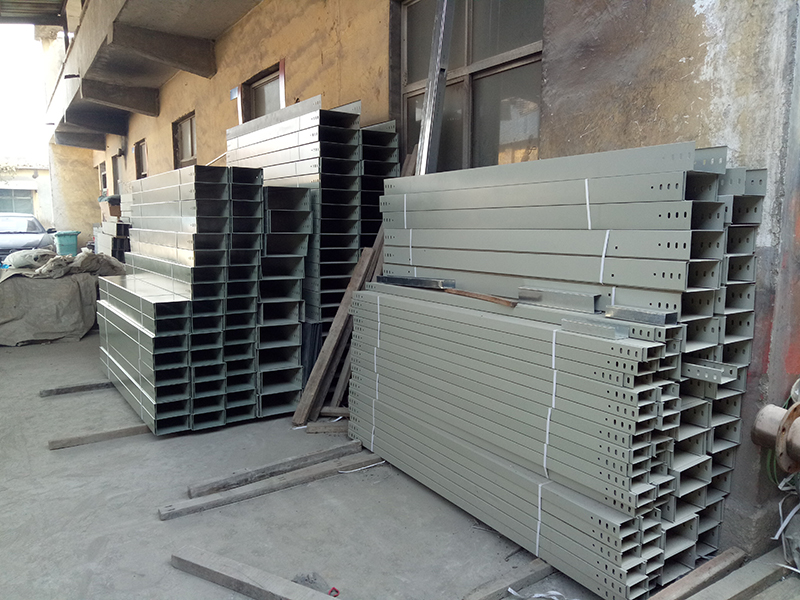桥架和线槽不能混为一谈,毕竟桥架和线槽是两个感念,而在使用的过程中自然是不能一概而论,使用应注意分别。下面来讲讲相关内容吧。
Bridge and trunking should not be confused. After all, bridge and trunking are two thoughts, which can not be generalized in the process of use. Attention should be paid to differences in use. Let's talk about the relevant contents.
1. Different strengths. Jinan Bridge is mainly used for laying power cables and control cables. The trunking has low strength and is usually used for laying wires and communication cables, such as Internet telephone.
2.转弯半径不同。桥架的弯曲半径比较大,线槽多为直角弯曲。
2. Different turning radii. The bending radius of the bridge is relatively large, and the trunking is mostly bent at right angles.
3.跨度不同。桥架跨度比较大,线槽比较小。因此,固定支架差别很大,支吊架的数量差别很大。
3. Different spans. The bridge span is relatively large and the trunking is relatively small. Therefore, there are great differences in fixed supports and the number of supports and hangers.
4.填充率不同。根据JGJ16-20088.5.3,线槽内电线电缆的总截面不应超过线槽内截面的20%,载流导体不应超过30根,总截面不得超过电缆截面不应超过横截面的40%。这是由于安装高度不同造成的。对于较低的安装高度,必须有一个盖板。如果盖板散热不好,填充率要小一些。
4. The filling rate is different. According to jgj16-20088.5.3, the total section of wires and cables in the trunking shall not exceed 20% of the section in the trunking, the number of current carrying conductors shall not exceed 30, and the total section shall not exceed 40% of the cable section. This is due to different installation heights. For lower mounting heights, there must be a cover plate. If the heat dissipation of the cover plate is not good, the filling rate should be smaller.

5.不同的密封。金属线槽密封性好,无需支架支撑,可敷设在电缆沟和建筑夹层中。有些槽桥是半开放式的,必须用支架支撑,一般架设在屋内或屋外的空中。
5. Different seals. The metal trunking has good sealing performance and does not need support. It can be laid in cable trench and building interlayer. Some slot bridges are semi open and must be supported by supports. They are generally erected in the air inside or outside the house.
6.支吊架距离不同。根据JGJ16-2008,线槽不超过2m,桥架1.5~3m。
6. The distance between supports and hangers is different. According to jgj16-2008, the trunking shall not exceed 2M and the bridge shall be 1.5 ~ 3M.
7.安装方式不同。桥架有特殊规范(详见CECS31.91),但线槽固定没有特殊规范。
7. Different installation methods. There are special specifications for bridge (see cecs31.91 for details), but there are no special specifications for trunking fixation.
8.盖板问题。在CECS31《钢制电缆桥架工程设计规范》中,定义桥架为总称,盖板为附件。JGJ16-20088.10.3规定,当桥梁的安装高度不能满足要求时,应加盖保护。也就是说,桥这个词的定义是没有遮盖的。但在GB29415-2013《耐火电缆桥架箱》中,线槽包括盖板,是线槽的组成部分。
8. Cover plate problem. In cecs31 code for design of steel cable tray engineering, the tray is defined as the general name and the cover plate is the accessory. Jgj16-20088.10.3 stipulates that when the installation height of the bridge cannot meet the requirements, it shall be covered for protection. In other words, the definition of the word bridge is not covered. However, in gb29415-2013 fire resistant cable tray box, trunking includes cover plate, which is an integral part of trunking.
9.尺寸不同。桥架比较大(200×100到600×200),线槽比较小。如果电缆和电线较多,建议使用桥接器。
9. Different sizes. The bridge is relatively large (200) × 100 to 600 × 200), the trunking is relatively small. If there are many cables and wires, bridges are recommended.
10.材料的厚度不同。根据JGJ16-2008-5.1金属线槽又称槽型桥架,一般是由厚度为0.4-1.5mm的整块钢板弯制而成的槽形部分。从概念上讲,桥与桥的区别在于高宽比不同,托盘浅。虽然很宽,但金属线槽有一定的深度和封闭性。不过桥架比线槽强,多用于放置电缆,当然也可以放线,一般用于大功率系统。
10. The thickness of materials is different. According to jgj16-2008-5.1, metal trunking, also known as trough type bridge, is generally a trough shaped part bent from a whole steel plate with a thickness of 0.4-1.5mm. Conceptually, the difference between bridges lies in the different aspect ratio and shallow tray. Although it is very wide, the metal trunking has a certain depth and tightness. However, the bridge is stronger than the trunking. It is mostly used to place cables. Of course, it can also be set out. It is generally used in high-power systems.
电缆桥架作为布线工程的一个配套项目,目前尚无专门的规范指导,个别生产厂家的规格程式缺乏通用性,因此,设计选型过程应根据弱电各个系统缆线的类型、数量,合理选定适用的桥架。更多内容了解就来关注我们的网站
www.comprepyme.com吧。
At present, there is no reasonable specification for the selection of cable tray type and the applicability of each cable tray system. Therefore, there is no specific cable tray design process according to the specification of each cable tray type. For more information, follow our website.

 槽式电缆桥架安装高度为什么有标准?
槽式电缆桥架安装高度为什么有标准?